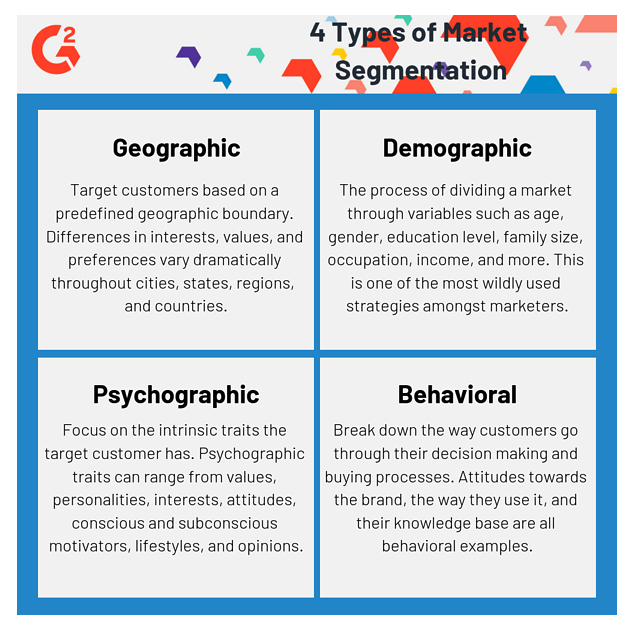Geographic target market segmentation involves dividing a market based on geographical boundaries. Businesses use this to tailor products and marketing strategies to specific regions.
Geographic segmentation allows companies to address the unique needs and preferences of customers in different areas. It involves analyzing factors such as climate, culture, language, and regional trends to better connect with the target audience. For instance, a company might market winter clothing in colder regions while promoting lightweight apparel in warmer areas.
This targeted approach helps businesses optimize their marketing efforts and resources, leading to increased customer satisfaction and higher sales. By understanding the geographical nuances of their market, companies can create more relevant and effective marketing campaigns that resonate with local consumers.

Credit: 1up.ai
The Essence Of Geographic Segmentation
Geographic segmentation divides a market by location. This can be by country, state, or city. It helps businesses understand local preferences. Companies can then tailor products and services.
Geographic segmentation is crucial in marketing. It allows businesses to focus on specific areas. This leads to better customer satisfaction. Localized marketing strategies boost sales. They also improve brand loyalty.
Analyzing Market Characteristics
Age groups in different regions can vary. Younger people may prefer trendy products. Older people might like classic items more. Income levels also affect buying habits. Wealthier areas may spend more on luxury goods. Less affluent regions might look for budget-friendly options.
People in different regions have unique cultures. These cultures influence their buying decisions. For example, some regions prefer spicy food. Others may like milder flavors. Traditional clothing styles can also vary by region. Understanding these cultural nuances helps in targeting the market effectively.
Techniques For Effective Segmentation
Geographic target market segmentation focuses on dividing a market based on location. This technique helps businesses tailor strategies to regional preferences, improving relevance and engagement.
Data Collection And Analysis
Data collection is key for market segmentation. Gather data on customer locations. Use surveys, sales data, and customer feedback. Analyze this data to find patterns. Look for trends in different regions. This helps in understanding regional needs.
Applying Gis In Market Research
GIS stands for Geographic Information Systems. It helps map customer locations. Use GIS to visualize data on maps. This makes it easy to spot trends. For example, see where most customers live. GIS can also show areas with high sales. This helps in targeting specific regions. Businesses can use GIS for better marketing strategies.

Credit: www.yieldify.com
Challenges In Geographic Segmentation
Data accuracy is crucial for geographic segmentation. Inaccurate data can lead to poor decisions. Always use reliable data sources. Validate data regularly. Cross-check data from multiple sources. Use technology to improve data accuracy. Invest in data cleaning tools. Train staff on data accuracy importance.
Markets change frequently. Stay updated with market trends. Regularly review market data. Adapt strategies quickly. Use real-time data tools. Monitor competitor actions. Be flexible with your plans. Prepare for unexpected changes. Stay ahead in dynamic markets.
Case Studies: Success Stories
Many local brands have found success on the global stage. Patagonia started in the United States. It is now popular worldwide. Their eco-friendly products attract many customers. Zara, a Spanish brand, expanded quickly. Its fast-fashion model appeals to many shoppers globally. These brands adapt their strategies to succeed in new markets.
Global brands often change to fit local tastes. McDonald’s offers unique menu items in different countries. In India, they serve the McAloo Tikki burger. Coca-Cola adjusts its marketing for each region. They use local languages and cultural symbols. These adaptations help brands connect with local customers.

Credit: adamantlinks.com
Strategies For Localized Marketing
Businesses can create special products for different regions. This helps in meeting local needs. For example, a clothing store can sell warm clothes in cold areas. In hot places, the store can offer light and cool clothes. By doing this, they can attract more customers.
Running ads that speak to local culture can boost sales. Use local language and symbols. This makes people feel connected. Sponsor local events and festivals. This shows that the business cares about the community. People will trust and support the brand more.
Frequently Asked Questions
What Are The 5 Ways Markets Can Be Segmented Geographically?
Markets can be segmented geographically by region, country, city, climate, and population density.
Which Of The Following Are Examples Of Geographic Segmentation?
Examples of geographic segmentation include regions, countries, states, cities, neighborhoods, climate zones, and urban or rural areas.
What Products Have Geographic Segmentation?
Products like food, clothing, and electronics often use geographic segmentation. Companies tailor offerings to local tastes and needs.
What Is Geo Demographic Segmentation In Marketing?
Geo demographic segmentation divides a market based on geographic and demographic factors. It helps target specific regional and social groups. Businesses use this strategy to tailor marketing efforts effectively.
What Is Geographic Target Market Segmentation?
Geographic target market segmentation divides a market based on location. This includes regions, cities, or neighborhoods.
Conclusion
Geographic target market segmentation enhances marketing strategies. It allows businesses to focus on specific regions. This approach improves customer satisfaction and boosts sales. Implementing geographic segmentation can lead to more effective marketing campaigns. Start leveraging geographic data to refine your marketing efforts and achieve better results.
